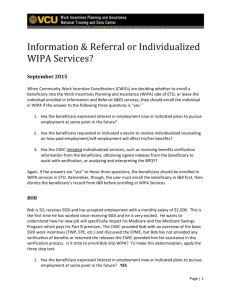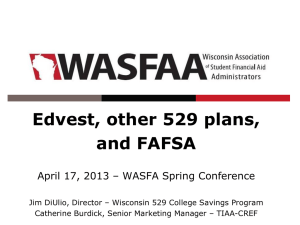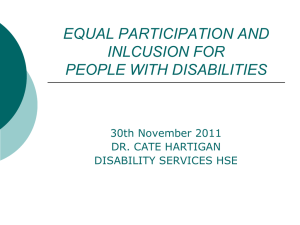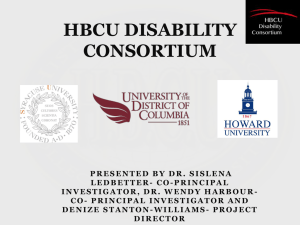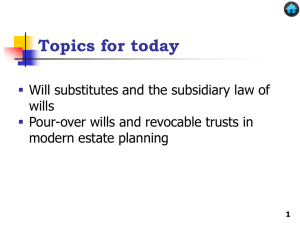Case File Components
advertisement
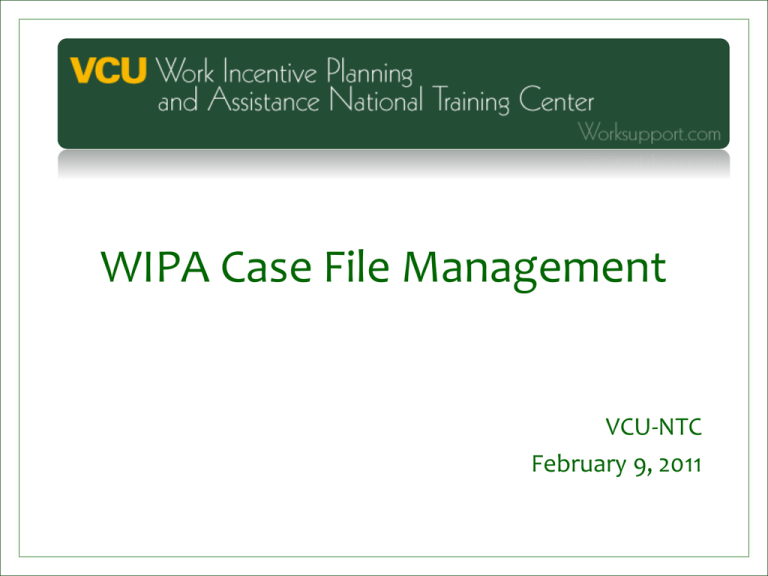
WIPA Case File Management VCU-NTC February 9, 2011 Learning Objectives • Review record keeping guidelines • Review minimum components for WIPA case files • Review confidentiality and disclosure concerns • Review guidelines for writing case notes Record Keeping Guidelines in the WIPA program • Record keeping in the WIPA program refers to more than just the management of the beneficiary case file • Record keeping in the WIPA program entails knowledge of proper procedural and documentation requirements – This is especially important when working with representative payees or other stakeholders Record Keeping Guidelines in the WIPA program • Confidentiality in the WIPA program – If WIPA is housed in a larger agency, case files are separate from all other agency records and are only accessible by CWICs – Access to locked files is limited to certified WIPA staff who have completed the federal security clearance required by SSA – Should generally NOT include forms or information related to other services the beneficiary has, or is receiving from the same provider agency under a different program Record Keeping Guidelines in the WIPA program • Confidentiality Requirements (continued) – All beneficiary information is confidential and is not to be shared without explicit consent from the beneficiary using signed releases of information – Files must be kept under lock and key unless in the CWIC’s physical possession; this includes keeping files in locked cases while traveling – When working from home, files must NOT be visible to others in the household – Computers should have the best of security features including password protections Case File Components • Case files should be consistent throughout the WIPA project! • Any eligible individual served by the WIPA project should have a case file – This includes beneficiaries who receive only I&R services Case File Components 1. Intake sheet 2. Case notes 3. Release of information forms 4. Correspondence used to verify ALL benefits (BPQY and any verification about other benefits received) 5. Verification that the beneficiary understands WIPA project policies and procedures 6. Copies of BS&As, WIPs, etc. 7. Copies of correspondence to and from other agencies 8. Copies of work incentives information 9. Cover sheet Case File Components 1. Intake sheet – Should include contact information and demographic data – No required form, but should include all the information SSA requires per the WIPA RFA – Tip: you can enter intake data directly into ETO and print out the completed form to include as the intake for the case file Case File Components 2. Case notes - Case notes should describe services rendered, issues discussed, actions taken - Address how you assisted the beneficiary and/or the beneficiary’s family in the access and coordination of benefits - Take note of any goals that were addressed - Case notes should appear in chronological order - Case notes should include any other clinically relevant information - Case notes should be dated and signed Case File Components 3. Copies of Release of Information Forms used to access benefits information from SSA or other federal, state, or local agencies - You MUST use the form SSA-3288 to access information about a beneficiary from the SSA - Other release of Information forms used by the agency must always indicate what information is being sought, be signed by the beneficiary and have an expiration date - For a list of all required components, see the following POMS: https://secure.ssa.gov/apps10/poms.nsf/lnx/020330500 1!opendocument#b2 Case File Components 4. Copies of Benefits Planning Queries (BPQYs), statement of benefits, and any correspondence verifying public benefits, food stamps, housing subsidies, TANF, Veterans benefits, Unemployment Insurance, Worker’s Compensation or any other public disability benefit current benefits status, payment amounts, or work incentives used - Release of Information must be on file for each item - Verification of Medicaid (i.e. Medicaid waivers, spenddown, 1619(b) etc.) - Verification of Medicare Savings Programs (i.e. QMB, SLMB); verification of Part D LIS Case File Components 5. Verification that the beneficiary has read and understands the WIPA project policies and procedures - Could consist of a signature sheet signed by the beneficiary, or the legal guardian and the CWIC - Minimally, these policies should cover the following: - Scope of services to be provided (including limitations) - Beneficiary responsibilities - WIPA service eligibility criteria - Confidentiality policy - Grievance/complaint procedure, or appeals process (including information on the PABSS program) - Any other beneficiary rights or disclaimers Case File Components 6. Copies of any Benefits Summaries and Analyses (BSA) reports, Work Incentives Plan (WIP) and summaries of other advisement provided or related correspondence - Includes SSI calculation sheets and Title II disability benefits charts or timelines - Monthly Budget/expenses - Monthly Hours worksheet - Earnings Record Grid - Referral Forms - Closure Summary (if applicable) Case File Components 7. Copies of any correspondence to and from other agencies - Letters to SSA or state Medicaid Department 8. Copies of work incentives information - PASS/IRWE/BWE documentation - Copies of pay stubs - SSA correspondence (i.e. Notice of change in benefits) Case Files Components 9. Cover sheet - use a checklist of included above items as a face sheet in files, to quickly assess any missing information that needs to be included, and to allow an efficient review of the case file. Case File Components • Optional Components – Surveys – Grievance and response forms (if applicable) – Miscellaneous •Fact sheets •List of information sent to client •ETO issues Case File Components • What WIPA case files should NOT include – No diagnostic, medical, or disability information, unless it is directly related to the WIPA services provided – No forms or information related to other services the beneficiary has or is receiving from the same provider agency under a different program – Value judgments or opinions Case File Quality Review • Do case notes document “just the facts” of services provided? • Are items identified in the initial intake form and on the BPQY covered in the BSA? • Are the recommendations in the BSA appropriate to the stated goal? • Does the information in the BSA flow in a logical manner? • Are appropriate calculation charts included? • Does the WIP reflect appropriate action steps as identified in the BSA? Case File Quality Review • Is there any missing information in either the BSA or the WIP? • Are appropriate updates to the BSA and WIP included? • Are all earnings reports and work incentives documentation current? • Is the file information presented in a clear and organized manner so that another CWIC could step in if necessary? • Are contacts with SSA and other relevant agencies noted and tracked? SSA case file reviews • To ensure proper data is maintained, SSA will review case files for the following components: – Initial Intake – Releases of Information – BPQY – Benefit Summary & Analysis – Work Incentive Plan – Contact Log – Wage Reports (if applicable) – Referral forms (if applicable) – Quality and Completeness – Other (as needed) • They will also ensure that benefits were verified as needed Confidentiality and Disclosure • When do I ask about a beneficiary’s disability? • What can I ask about a beneficiary’s disability? • What if the beneficiary does not disclose that he or she has a disability? • Right to privacy is also known as confidentiality • Respect the beneficiary’s right to control personal information and have access to it • Ask yourself: Why do I need to know? Is the disability relevant to the beneficiary’s employment goal? Case Notes • Case notes are a narrative description of activity conducted for, with, about, or on behalf of a beneficiary • Case notes are a required component of WIPA project record keeping! • Case notes are relevant to the development of the WIP and should always support the beneficiary’s employment plan Case Notes • Purpose of case notes – Provide a chronological description of services rendered to help CWIC stay organized – Document services rendered and progress made to funding and regulatory agencies – Allow multiple professionals working with the beneficiary to stay informed and up to date – Provide a historical record to insure continuity of services during staffing changes – Provide a way for project managers to assess quality of services – Serve as a legal document if a case record is subpoenaed Case Notes • Case Notes Dos – Do describe services rendered and results achieved – Do record progress (or lack thereof) – Be clear, concise and accurate – Use direct quotes (when appropriate) – Write notes for each contact – D.A.T.E. : Do At Time of Event – Sign and Date every entry (signatures must be original) – For mistakes, cross out with a single line and initial Case Notes • Case Notes Dos (cont’d) – Be sure to substantiate conclusions and inferences – Be sure to link case notes to services related to the beneficiary's employment or work incentive activities – Describe observations and behaviors relevant to the beneficiary’s goal and work incentive plan – Be detailed enough to convey necessary information Case Notes • Case Notes Don’ts – Don’t make value judgments, assumptions, or guesses – No blank spaces, white out, or scribbles – No one else can write your case notes for you! – Avoid stereotypes, opinions, and diagnoses Case Notes – Respectful Language • Poor: Mr. Jones is a 33 year old handicapped male. He is looking for work, but only has one arm. He says he lost it in a motorcycle accident 10 years ago. He has a false arm that he uses when he works. • Sometimes we think using Mr. or Mrs. will make all the difference in what we write. Rather, it is the language we choose that is important. • How might you change the above paragraph, using respectful language? Case Notes – Respectful Language • Good: Dennis is a dislocated worker who requests assistance in finding work. He stated that he has five years experience as a shipping and receiving clerk. He would like to continue the same type of work and needs a minor accommodation in order to operate a computer. • How does this version differ from the previous one? Case Notes – Non-judgmental Language • Poor: Jane looks and smells as though she has not bathed in days. She just sat there when I asked questions about her work history. She could be slow or just lazy. • How might you change this paragraph to make it more appropriate and non-judgmental? Case Notes – Non-judgmental Language • Good: Jane appears to have poor hygiene. Additionally, she did not make eye contact, nor would she respond to questions. • How does this statement differ from the previous one? Case Notes – Clear Description • Poor: Andrea seemed to be distracted and obviously nervous. • Watch for the use of non-specific and misleading words. Give a description. Show, instead of tell. Use the word “appear” instead of “seems”. • How would you change the above statement to make it clearer? Case Notes – Clear Description • Good: Joan was shifting in her seat and chipped at her nail polish during the meeting. • How does this statement differ from the previous one? Appropriate Language Words to avoid Acceptable alternatives Abnormal, subnormal Specify the disability Afflicted with Birth defect, congenital defect, deformity Individual has Individual with a disability since birth, individual with a congenital disability The blind, the visually impaired Individual who is blind, individual with a vision impairment Confined to a wheelchair Uses a wheelchair Appropriate Language Words to Avoid Acceptable alternatives Cripple, crippled Has a physical disability, has a mobile disability Hearing Impaired Individual is deaf, the Deaf Defective, deformed Specify the disability Dwarf Individual of short-stature Epileptic Individual with epilepsy Attack, spell, fit Seizure Insane, manic, lunatic Individual with a psychiatric disability Appropriate Language (cont’d) Words to Avoid Mentally retarded Acceptable alternatives Suffers from Victim Individual with an intellectual disability Individual with a disability Has a disability Able-bodied Despite disability Challenged Non-disabled Because of ability Don’t Use Final Comments • Case File Management is a key component of any quality assurance process! • Project Managers should use a case file checklist to complete the case file reviews Questions?
